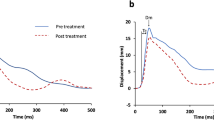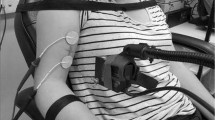Abstract
The purpose of this study was to examine the time course of adaptation through 20 days of eccentric training and 5 days of detraining. A total of 22 untrained subjects trained one arm every 2nd day for 20 days. Subjects performed maximal isokinetic eccentric biceps brachii training at 90°/s (six sets of eight reps). Muscle thickness (reported in cm) via ultrasound, strength (reported in Nm) and muscle activation (electromyography) were measured before, during, and after training (nine time points). Strength in the trained arm decreased after 8 days of training (65.6 ± 4.1 to 57.5 ± 3.5; p < 0.05) and remained decreased throughout the study. Agonist muscle activation amplitude of the trained arm increased after 14 days of training (p < 0.05) and remained elevated throughout the study. Antagonist muscle activation decreased after 20 days of training (p < 0.05). Muscle thickness increased after 8 days of training (3.66 ± 0.11 to 3.90 ± 0.12; p < 0.05) and remained above baseline until the end of training (3.97 ± 0.12). After 5 days of detraining, muscle thickness decreased (3.97 ± 0.12 vs. 3.85 ± 0.11; p < 0.05), but remained higher than baseline (p < 0.05). Muscle thickness did not change significantly in the untrained arm at any time point. In conclusion, the early increase in biceps brachii muscle thickness coupled with a significant decrease in strength is an indicator of muscle damage leading to swelling and impaired muscle function. The persistent decrease in strength, despite an increase in muscle activation, suggests that the recovery interval was inadequate to allow complete repair of muscle damage. Intense eccentric training performed every 2nd day leads to a prolonged impairment of muscle strength in previously untrained individuals.




Similar content being viewed by others
References
Abe T, DeHoyos DV, Pollock ML, Garzarella L (2000) Time course for strength and muscle thickness changes following upper and lower body resistance training in men and women. Eur J Appl Physiol Occup Physiol 81:174–180
Barry BK, Riley ZA, Pascoe MA, Enoka RM (2008) A spinal pathway between synergists can modulate activity in human elbow flexor muscles. Exp Brain Res 190:347–359
Buchanan TS, Rovai GP, Rymer WZ (1989) Strategies for muscle activation during isometric torque generation at the human elbow. J Neurophysiol 62:1201–1212
Candow DG, Chilibeck PD (2005) Differences in size, strength, and power of upper and lower body muscle groups in young and older men. J Gerontol A Biol Sci Med Sci 60:148–156
Candow DG, Chilibeck PD, Facci M, Abeysekara S, Zello GA (2006) Protein supplementation before and after resistance training in older men. Eur J Appl Physiol 97:548–556
Carolan B, Cafarelli E (1992) Adaptations in coactivation after isometric resistance training. J Appl Physiol 73:911–917
Chapman D, Newton M, Sacco P, Nosaka K (2006) Greater muscle damage induced by fast versus slow eccentric exercise. Int J Sports Med 27:591–598
Crameri RM, Langberg H, Magnusson P, Jensen CH, Schrøoder HD, Olesen JL, Suetta C, Teisner B, Kjaer M (2004) Changes in satellite cells in human skeletal muscle after a single bout of high intensity exercise. J Physiol 558:333–340
Dreyer HC, Blanco CE, Sattler FR, Schroeder ET, Wiswell RA (2006) Satellite cell numbers in young and older men 24 hours after eccentric exercise. Muscle Nerve 33:242–253
Farthing JP, Chilibeck PD (2003a) The effects of eccentric training at different velocities on cross-education. Eur J Appl Physiol 89:570–577
Farthing JP, Chilibeck PD (2003b) The effects of eccentric and concentric training at different velocities on muscle hypertrophy. Eur J Appl Physiol 89:578–586
Farthing JP, Chilibeck PD, Binsted G (2005) Cross-education of arm muscular strength is unidirectional in right-handed individuals. Med Sci Sports Exerc 37:1594–1600
Harwood B, Edwards DL, Jakobi JM (2010) Age independent and position-dependent alterations in motor unit activity of the biceps brachii. Eur J Appl Physiol. doi:10.1007/s00421-010-1438-2 [Epub ahead of print]
Howatson GK, van Someren A, Hortobágyi T (2007) Repeated bout effect after maximal eccentric exercise. Int J Sports Med 28:557–563
Ikai M, Fukunaga T (1970) A study on training effect on strength per unit cross-sectional area of muscle by means of ultrasonic measurement. Int Z Angew Physiol 28:173–180
Jamurtas AZ, Theocharis V, Tofas T, Tsiokanos A, Yfanti C, Paschalis V, Koutedakis Y, Nosaka K (2005) Comparison between leg and arm eccentric exercises of the same relative intensity on indices of muscle damage. Eur J Appl Physiol 95:179–185
Krentz JR, Quest B, Farthing JP, Quest DW, Chilibeck PD (2008) The effects of ibuprofen on muscle hypertrophy, strength, and soreness during resistance training. Appl Physiol Nutr Metab 33:470–475
Kumar V, Selby A, Rankin D, Patel R, Atherton P, Hildebrandt W, Williams J, Smith K, Seynnes O, Hiscock N, Rennie MJ (2009) Age-related differences in the dose–response relationship of muscle protein synthesis to resistance exercise in young and old men. J Physiol 587:211–217
Masuda K, Masuda T, Sadoyama T, Inaki M, Katsuta S (1990) Changes in surface EMG parameters during static and dynamic fatiguing contractions. J Electromyogr Kinesiol 9:39–46
Moore DR, Phillips SM, Babraj JA, Smith K, Rennie MJ (2005) Myofibrillar and collagen protein synthesis in human skeletal muscle in young men after maximal shortening and lengthening contractions. Am J Physiol Endocrinol Metab 288:E1153–E1159
Moritani T, deVries HA (1979) Neural factors versus hypertrophy in the time course of muscle strength gain. Am J Phys Med 58:115–130
Narici MV, Roi GS, Landoni L, Minetti AE, Cerretelli P (1989) Changes in force, cross-sectional area and neural activation during strength training and detraining of the human quadriceps. Eur J Appl Physiol Occup Physiol 59:310–319
Nosaka K, Clarkson PM (1996) Changes in indicators of inflammation after eccentric exercise of the elbow flexors. Med Sci Sports Exerc 28:953–961
Nosaka K, Newton M (2002) Repeated eccentric exercise bouts do not exacerbate muscle damage and repair. J Strength Cond Res 16:117–122
Nosaka K, Sakamoto K, Newton M, Sacco P (2001) How long does the protective effect on eccentric exercise-induced muscle damage last? Med Sci Sports Exerc 33:1490–1495
O’Reilly SC, Jones A, Muir KR, Doherty M (1998) Quadriceps weakness in knee osteoarthritis: the effect on pain and disability. Am Rheum Dis 57:588–594
Peake J, Nosaka K, Suzuki K (2005) Characterization of inflammatory responses to eccentric exercise in humans. Exerc Immunol Rev 11:64–85
Phillips SM, Tipton KD, Aarsland A, Wolf SE, Wolfe RR (1997) Mixed muscle protein synthesis and breakdown after resistance exercise in humans. Am J Physiol Endocrinol Metab 273:E99–E107
Rabita G, Pérot C, Lensel-Corbeil G (2000) Differential effect of knee extension isometric training on the different muscles of the quadriceps femoris in humans. Eur J Appl Physiol 83:531–538
Reeves ND, Maganaris CN, Narici MV (2005) Plasticity of dynamic muscle performance with strength training in elderly humans. Muscle Nerve 31:355–364
Sale DG (1988) Neural adaptations to resistance training. Med Sci Sports Exerc 20:S135–S145
Seger J, Arvidsson B, Thorstensson A (1998) Specific effects of eccentric and concentric training on muscle strength and morphology in humans. Eur J Appl Physiol 79:49–57
Seynnes OR, de Boer M, Narici MV (2007) Early skeletal muscle hypertrophy and architectural changes in response to high-intensity resistance training. J Appl Physiol 102:368–373
Shepstone TN, Tang JE, Dallaire S, Schuenke MD, Staron RS, Phillips SM (2005) Short-term high- vs. low-velocity isokinetic lengthening training results in greater hypertrophy of the elbow flexors in young men. J Appl Physiol 98:1768–1776
Staron RS, Karapondo DL, Kraemer WJ, Fry AC, Gordon SE, Falkel JE, Hagerman FC, Hakida RS (1994) Skeletal muscle adaptation during early phase of heavy-resistance training in men and women. J Appl Physiol 76:1247–1255
Tokmakidis SP, Kokkinidis EA, Smilios I, Douda H (2003) The effects of ibuprofen on delayed muscle soreness and muscular performance after eccentric exercise. J Strength Cond Res 17:53–59
Acknowledgments
Joel Krentz was supported by a graduate scholarship from the Natural Sciences and Engineering Research Council of Canada (NSERC). The isokinetic dynamometer used in this project was funded by an equipment grant from the Saskatchewan Health Research Foundation (SHRF) awarded to Dr. Jonathan Farthing.
Author information
Authors and Affiliations
Corresponding author
Additional information
Communicated by Toshio Moritani.
Rights and permissions
About this article
Cite this article
Krentz, J.R., Farthing, J.P. Neural and morphological changes in response to a 20-day intense eccentric training protocol. Eur J Appl Physiol 110, 333–340 (2010). https://doi.org/10.1007/s00421-010-1513-8
Accepted:
Published:
Issue Date:
DOI: https://doi.org/10.1007/s00421-010-1513-8




